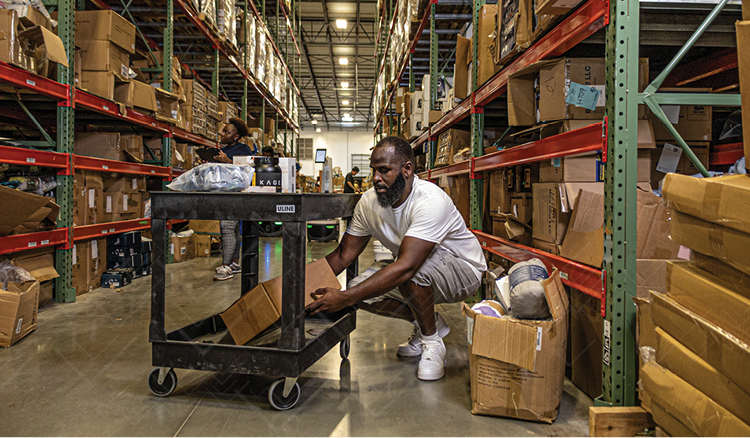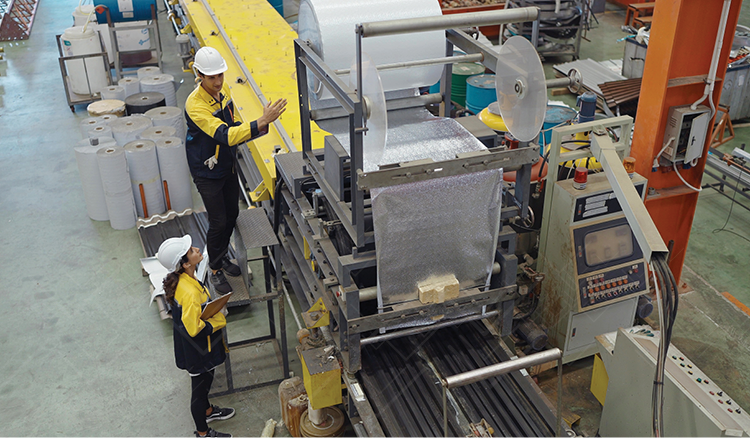Missed Projections: Salvaging the Season with On-Demand Labor
Success isn’t about achieving perfection; it’s about adapting swiftly before mistakes turn into losses.
Sometimes our best projections in business turn out to be wrong. Consumer preferences shift unexpectedly, a product design may become an unforeseen hit or fall flat, or external factors like port delays and strikes disrupt transit times and supply chains. These missteps are inevitable in an unpredictable world, but they don’t define failure.
Companies don’t fail because of a single wrong prediction but because they assume a forecast is accurate, then fail to adjust to new information. The ability to pivot and respond quickly separates resilient businesses from those that can't, or worse, simply won't.
Critical decisions regarding inventory, labor, and production are often based on projections that miss the mark. When these forecasts fall short—and they frequently do—the consequences are both costly and disruptive. McKinsey & Company reports that excess inventory costs U.S. businesses over $50 billion annually (“Reimagining Retail”). But financial losses are just the tip of the iceberg. Rigid planning leads to overproduction, markdowns, and frantic recovery efforts, draining resources and eroding profits. As Nassim Nicholas Taleb aptly warns in Antifragile, “Forecasts are fragile—they collapse under the weight of the unexpected.”
For businesses in the midst of peak season, the flaws in these plans become glaringly obvious. A single erroneous prediction can trigger a cascade of missed deadlines, increased overtime costs, and warehouses overflowing with unsellable products. The pressing question isn’t what went wrong—it’s how to fix it. With only weeks to course-correct, adaptability becomes not just a strategy but a necessity for survival.
The Hidden Costs of Inaccurate Forecasts
When forecasts miss the mark, the ripple effects spread across every facet of operations, driving inefficiencies that cost businesses millions. Inaccurate predictions about labor, inventory, and production needs can lead to overproduction, overtime costs, and inventory bottlenecks. These missteps come with a hefty price. Excess inventory, underutilized resources, and missed opportunities combine to erode profitability and operational efficiency. According to a report from the Council of Supply Chain Management Professionals (CSCMP), inventory carrying costs increased by 25% in recent years, highlighting the growing burden of poor planning. These costs go beyond financial losses—they impact employee morale, strain customer relationships, and create bottlenecks that undermine agility and growth.
For manufacturers, poor forecasting often results in overproducing low-demand items, leaving high-priority SKUs understocked. This mismatch not only ties up capital but also forfeits market opportunities to competitors. Distribution centers and logistics operations face similar challenges, with overstocked warehouses and inefficient workflows leading to delays and missed delivery windows. According to Supply Chain Dive, “60% of supply chain professionals cited inventory and demand misalignment as their biggest operational challenge.” This alignment failure highlights the importance of shifting away from rigid strategies and embracing adaptability to meet real-time demand.
The most significant cost, however, lies in the failure to adapt when things go wrong. Businesses that can’t pivot quickly to address issues are often left scrambling, driving up overtime costs and draining resources. On the other hand, companies that embrace agility can turn challenges into opportunities, responding to shifting conditions with flexibility. As noted by Deloitte’s supply chain insights, “Organizations that build adaptive capabilities recover faster and perform better during disruptions.” Recognizing the hidden costs of forecasting failures is the first step in creating strategies that are not only reactive but also resilient.
For Manufacturers
• Overproduction: Excess production of low-demand SKUs ties up capital and occupies storage needed for high-demand items.
• Missed Demand Spikes: Delayed production of in-demand products leads to lost market opportunities and cedes ground to competitors.
• Employee Burnout: Overworking fixed teams results in errors, decreased morale, and potential turnover.
For Distribution Operations
• Overstocked Warehouses: Unsold goods fill warehouses to capacity, leaving no room for fast-selling items.
• Inefficient Workflows: Labor shortages create bottlenecks in receiving, picking, and packing, slowing down outbound shipments.
• Increased Costs: Reliance on overtime escalates expenses and heightens the risk of mistakes due to fatigue.
For Logistics Companies
• Dock Congestion: Limited dock labor slows unloading, staging, and loading processes, delaying truck turnarounds.
• Disorganized Storage: Inefficient putaway procedures strand goods in suboptimal locations, increasing handling times.
• Missed Schedules: Shortage of dock workers or driver helpers delays outbound shipments, leading to penalties and dissatisfied customers.
Strategies to Salvage Peak Season
When forecasts fall short, the cost is clear, but the path to recovery can feel overwhelming. Peak season magnifies these challenges, leaving businesses grappling with overstocked warehouses, labor shortages, and missed deadlines. The reality is that peak season waits for no one, and the time to adapt is now. The good news? The same disruptions that expose weaknesses in rigid planning also create opportunities for businesses willing to embrace agility. As operations leaders, the key is not just reacting to challenges but implementing strategies that turn chaos into control and inefficiency into momentum.
1. Rapid Deployment of On-Demand Labor
Peak season doesn’t wait, and traditional hiring cycles can’t meet immediate labor demands. On-demand labor platforms like Veryable enable businesses to scale their workforce within 12 hours.
• Manufacturers: Bring in skilled operators to ramp up production lines for high-priority SKUs.
• Distribution Operations: Add workers to receiving, picking, packing, or staging areas to eliminate bottlenecks and ensure timely shipments.
• Logistics Companies: Assign personnel to unloading, staging, and dock support to expedite truck turnarounds and prevent delays.
2. Prioritize High-Impact Activities
Not all tasks are created equal. Focus labor resources on critical areas to maximize efficiency and throughput.
• Manufacturers: Concentrate on producing high-margin or fast-selling items, avoiding the allocation of resources to low-demand products.
• Distribution Operations: Redirect labor to fulfill high-priority orders, ensuring key customer deadlines are met.
• Logistics Companies: Allocate operators to efficiently unload and stage goods, getting trucks back on the road promptly.
3. Optimize Dock and Warehouse Operations
Inefficiencies can quickly escalate during peak times. Utilize on-demand labor to address specific chokepoints and maintain operational flow.
• Manufacturers: Add staff for inventory management and production support to minimize downtime between shifts.
• Distribution Operations: Employ operators for cross-docking or staging high-demand products to facilitate quick turnover.
• Logistics Companies: Increase dock labor to reduce unloading times, reorganize staging areas, and keep driver schedules on track.
4. Enhance Communication Across Teams
Clear communication is vital in managing peak season challenges. Proactive coordination ensures alignment between production, warehouse, and logistics teams.
• Manufacturers: Sync production schedules with warehouse capacities to prevent receiving delays.
• Distribution Operations: Collaborate closely with logistics teams to prioritize shipments for key clients.
• Logistics Companies: Keep drivers and dispatchers informed about dock conditions and loading times to manage expectations.
5. Build Agility for Future Peak Seasons
Leverage real-time data from the current peak season to refine future planning, integrating on-demand labor as a foundational element of your strategy.
• Manufacturers: Monitor labor efficiency on production lines to identify areas for improvement.
• Distribution Operations: Analyze metrics for picking, packing, and shipping to streamline workflows.
• Logistics Companies: Review dock operations data to pinpoint where labor shortages caused delays, allowing for more flexible staffing in the future.
The Ripple Effects of Agility
When businesses adapt quickly and decisively, the benefits extend far beyond immediate problem-solving. Agility during peak season doesn’t just prevent costly mistakes—it creates a ripple effect that transforms every stage of operations. From the production floor to the loading dock, flexible labor strategies and streamlined workflows unlock improvements in productivity, cost efficiency, and customer satisfaction. As reported by Deloitte, “Organizations with adaptable operations consistently outperform peers in both resilience and profitability.”
For manufacturers, the ripple effect means sustained production during demand spikes, reduced reliance on overtime, and minimized waste. Instead of overproducing low-demand SKUs or rushing to fill gaps, businesses can prioritize high-margin items and optimize their workforce to match real-time needs. This agility improves output while reducing strain on core teams, resulting in better morale and lower turnover rates.
Distribution centers and logistics operations also see significant gains. By eliminating bottlenecks in receiving, picking, and shipping, businesses can ensure on-time deliveries while reducing errors and penalties. Faster truck turns and smoother workflows improve service levels, enhancing relationships with key customers. These operational efficiencies are not just reactive fixes—they’re proactive measures that prepare businesses to handle future disruptions more effectively.
Agility is about more than responding to today’s challenges—it’s about building a foundation for long-term success. By understanding how small changes in labor and workflows can drive larger improvements across the entire supply chain, businesses can create an operational advantage that endures well beyond peak season.
For Manufacturers
• Increased Productivity: On-demand labor keeps production lines operational during unexpected demand spikes.
• Cost Savings: Scaling labor reduces the need for expensive overtime and mitigates employee burnout.
• Reduced Waste: Focusing on in-demand SKUs minimizes overproduction and the need for markdowns.
For Distribution Operations
• Improved Workflows: Additional staff eliminate bottlenecks, ensuring smooth movement of inventory from receiving to shipping.
• Enhanced Accuracy: Adequate staffing reduces errors in picking and packing by preventing rushed work.
• Timely Deliveries: Scaling labor during peak periods ensures that critical orders are shipped on schedule.
For Logistics Companies
• Faster Turnarounds: More dock personnel accelerate unloading and staging, minimizing driver wait times.
• Avoided Penalties: Maintaining schedules prevents missed delivery windows and associated financial repercussions.
• Higher Customer Satisfaction: Efficient dock operations lead to prompt shipments, enhancing client relationships.
Perfection is unattainable. Agility is unstoppable.
While forecasts may never be perfect, your outcomes can be. The ability to adapt quickly to unexpected changes—whether in consumer demand, supply chain disruptions, or labor availability—is what separates thriving businesses from those left behind. Agility isn’t just about solving immediate problems; it’s about creating systems and strategies that transform mistakes into opportunities. By scaling labor dynamically and focusing on high-impact activities, businesses can maintain efficiency and profitability even in the most unpredictable environments. Platforms like Veryable empower manufacturers, warehouses, and logistics companies to meet real-time demand with flexible, skilled operators who fill critical gaps and drive performance when it matters most.
The key to future success lies not in eliminating uncertainty, but in building the ability to navigate it. Companies that prioritize agility can proactively address challenges, ensuring continuity of operations and maintaining customer satisfaction. This shift from rigid planning to responsive execution unlocks new levels of efficiency and resilience. The ripple effects of such adaptability extend beyond the immediate season, setting the stage for sustained growth and stronger, more agile operations in the years ahead. As one business leader noted in a Deloitte study, “We don’t just survive disruption—we use it as a catalyst to redefine what’s possible.”
By acting decisively now, businesses can not only salvage the current peak season but also turn it into a proving ground for operational excellence. This is the time to replace reactive measures with proactive strategies that reduce costs, optimize resources, and ensure long-term success. Agility doesn’t just fix what’s broken; it creates a foundation for innovation, empowering teams to focus on what they do best and leaving room for future opportunities.
Perfection is unattainable. Agility is unstoppable. Businesses that embrace this mindset will find that even in the most turbulent times, they can emerge stronger, more competitive, and better prepared to face whatever comes next.
Getting Started
To get started with on-demand labor, take 5 minutes to create your free business profile. Our team of experts will reach out shortly after to walk you through the process and ensure that your team is setup for success. If you need any assistance, please contact us.
Previous Posts
How Policy Constraints, Not Just Production Bottlenecks, Threaten Your Bottom Line
The Future of Manufacturing and Logistics
Create a free business profile today to explore our platform.






